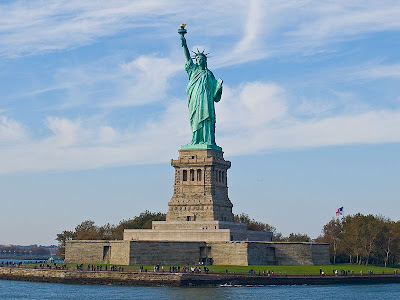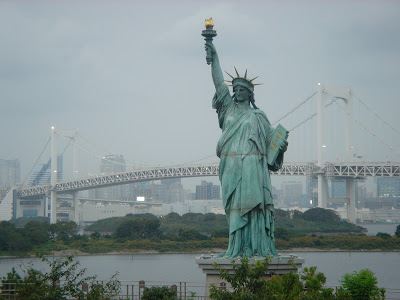The Statue of Liberty (French: Statue de la Liberté), officially titled Liberty Enlightening the World (French: la Liberté éclairant le monde), dedicated on October 28, 1886, is a monument commemorating the centennial of the signing of the United States Declaration of Independence, given to the United States by the people of France to represent the friendship between the two countries established during the American Revolution. It represents a woman wearing a stola, a radiant crown and sandals, trampling a broken chain, carrying a torch in her raised right hand and a tabula ansata, where the date of the Declaration of Independence JULY IV MDCCLXXVI is inscribed, in her left arm. Standing on Liberty Island in New York Harbor, it welcomes visitors, immigrants, and returning Americans traveling by ship. Frédéric Auguste Bartholdi sculpted the statue and obtained a U.S. patent for its structure. Maurice Koechlin-chief engineer of Gustave Eiffel's engineering company and designer of the Eiffel Tower-engineered the internal structure. The pedestal was designed by architect Richard Morris Hunt. Eugène Viollet-le-Duc was responsible for the choice of copper in the statue's construction, and for the adoption of the repoussé technique, where a malleable metal is hammered on the reverse side.

The statue is made of a sheathing of pure copper, hung on a framework of steel (originally puddled iron) with the exception of the flame of the torch, which is coated in gold leaf (originally made of copper and later altered to hold glass panes). It stands atop a rectangular stonework pedestal with a foundation in the shape of an irregular eleven-pointed star. The statue is 151 ft (46 m) tall, but with the pedestal and foundation, it is 305 ft (93 m) tall.
Worldwide, the Statue of Liberty is one of the most recognizable icons of the United States. and was, from 1886 until the Jet Age, often one of the first glimpses of the United States for millions of immigrants after ocean voyages from Europe.
The statue is the central part of Statue of Liberty National Monument, administered by the National Park Service. The National Monument also includes Ellis Island.
The classical appearance (Roman stola, sandals, facial expression) derives from Libertas, ancient Rome's goddess of freedom from slavery, oppression, and tyranny. Her raised right foot is on the move. This symbol of Liberty and Freedom is not standing still or at attention in the harbor, it is moving forward, as her left foot tramples broken shackles at her feet, in symbolism of the United States' wish to be free from oppression and tyranny. Since the 1940s, it has been claimed that the seven spikes or diadem atop of the crown epitomize the Seven Seas and seven continents. Her torch signifies enlightenment. The Keystone in her hand represents knowledge and shows the date of the United States Declaration of Independence, in Roman numerals, July IV, MDCCLXXVI.

The general appearance of the statue’s head approximates the Greek Sun-god Apollo or the Roman Sun-god Helios as preserved on an ancient marble tablet (today in the Archaeological Museum of Corinth, Corinth, Greece)-Apollo was represented as a solar deity, dressed in a similar robe and having on its head a "radiate crown" with the seven spiked rays of the Helios-Apollo's sun rays, like the Statue's nimbus or halo. The ancient Colossus of Rhodes, one of the Seven Wonders of the Ancient World, was a statue of Helios with a radiate crown. The Colossus is referred to in the 1883 sonnet The New Colossus by Emma Lazarus. Lazarus's poem was later engraved on a bronze plaque and mounted inside the Statue of Liberty in 1903.
To different observers, the statue has reminded of the values that the United States seemingly does or should possess. For example, documentarian Ken Burns recounts how the statue became a symbol of "America's open-door policy." In his book, Man's Search for Meaning, the existential therapist Viktor Frankl recommended "that the Statue of Liberty on the East Coast should be supplemented by a Statue of Responsibility on the West Coast."
The Statue of Liberty quickly became a popular icon, featured in scores of posters, pictures, motion pictures, and books. A 1911 O. Henry story relates a fanciful conversation between "Mrs. Liberty" and another statue; it figured in 1918 Liberty Loan posters. During the 1940s and 1950s, pulp Science Fiction magazines featured Lady Liberty surrounded by ruins or by the sediments of the ages. It has been in dozens of motion pictures. It is a setting in the 1942 Alfred Hitchcock movie Saboteur, which featured a climactic confrontation at the statue. Half submerged in the sand, the Statue provided the apocalyptic revelation at the end of 1968's Planet of the Apes. The statue walked from Liberty Island to Manhattan in the 1989 film, Ghostbusters II, to defeat the villain with positive energy when it inspired hope amongst cheering New Yorkers. It was the setting for the climax of the first X-Men film. It can also be seen lying broken on the ground in the movie Independence Day, after the first wave of attacks by extraterrestrials. In the 2004 movie The Day After Tomorrow, the statue gets frozen, and in the 2008 movie Cloverfield, it is decapitated by a giant monster; its head lands in a Manhattan street. In the 1994 Gundam series G Gundam, the protagonist hides his Gundam in the abandoned statue and then makes it jump out of the statue, destroying it. In the film, National Treasure: Book of Secrets, the sister statue in Paris provides a clue. The history of the Statue of Liberty is retold in the hit 2008 illustrated book Lady Liberty: A Biography.

It was the subject of a 1978 -University of WisconsinMadison prank in which Lady Liberty appeared to be standing submerged in a frozen-over local lake. It has appeared on New York and New Jersey license plates, is used as a logo for the NHL's New York Rangers and the WNBA's New York Liberty, and it was the subject of magician David Copperfield's largest vanishing act.
In 1982 Jessica Skinner was born inside the statue. Her mother went into labor while climbing the stairs, and gave birth before she could get back to ground level.
In Men in Black II, an emergency neuralizer is built into the Statue of Liberty to erase everyone's memories in case of a mass display.
It also starred in the video game Grand Theft Auto IV, in which it's called "The Statue of Happiness", since the statue is smiling in the game. It also holds up a cup of coffee instead of a torch.

The statue is made of a sheathing of pure copper, hung on a framework of steel (originally puddled iron) with the exception of the flame of the torch, which is coated in gold leaf (originally made of copper and later altered to hold glass panes). It stands atop a rectangular stonework pedestal with a foundation in the shape of an irregular eleven-pointed star. The statue is 151 ft (46 m) tall, but with the pedestal and foundation, it is 305 ft (93 m) tall.
Worldwide, the Statue of Liberty is one of the most recognizable icons of the United States. and was, from 1886 until the Jet Age, often one of the first glimpses of the United States for millions of immigrants after ocean voyages from Europe.
The statue is the central part of Statue of Liberty National Monument, administered by the National Park Service. The National Monument also includes Ellis Island.
The classical appearance (Roman stola, sandals, facial expression) derives from Libertas, ancient Rome's goddess of freedom from slavery, oppression, and tyranny. Her raised right foot is on the move. This symbol of Liberty and Freedom is not standing still or at attention in the harbor, it is moving forward, as her left foot tramples broken shackles at her feet, in symbolism of the United States' wish to be free from oppression and tyranny. Since the 1940s, it has been claimed that the seven spikes or diadem atop of the crown epitomize the Seven Seas and seven continents. Her torch signifies enlightenment. The Keystone in her hand represents knowledge and shows the date of the United States Declaration of Independence, in Roman numerals, July IV, MDCCLXXVI.

The general appearance of the statue’s head approximates the Greek Sun-god Apollo or the Roman Sun-god Helios as preserved on an ancient marble tablet (today in the Archaeological Museum of Corinth, Corinth, Greece)-Apollo was represented as a solar deity, dressed in a similar robe and having on its head a "radiate crown" with the seven spiked rays of the Helios-Apollo's sun rays, like the Statue's nimbus or halo. The ancient Colossus of Rhodes, one of the Seven Wonders of the Ancient World, was a statue of Helios with a radiate crown. The Colossus is referred to in the 1883 sonnet The New Colossus by Emma Lazarus. Lazarus's poem was later engraved on a bronze plaque and mounted inside the Statue of Liberty in 1903.
To different observers, the statue has reminded of the values that the United States seemingly does or should possess. For example, documentarian Ken Burns recounts how the statue became a symbol of "America's open-door policy." In his book, Man's Search for Meaning, the existential therapist Viktor Frankl recommended "that the Statue of Liberty on the East Coast should be supplemented by a Statue of Responsibility on the West Coast."
The Statue of Liberty quickly became a popular icon, featured in scores of posters, pictures, motion pictures, and books. A 1911 O. Henry story relates a fanciful conversation between "Mrs. Liberty" and another statue; it figured in 1918 Liberty Loan posters. During the 1940s and 1950s, pulp Science Fiction magazines featured Lady Liberty surrounded by ruins or by the sediments of the ages. It has been in dozens of motion pictures. It is a setting in the 1942 Alfred Hitchcock movie Saboteur, which featured a climactic confrontation at the statue. Half submerged in the sand, the Statue provided the apocalyptic revelation at the end of 1968's Planet of the Apes. The statue walked from Liberty Island to Manhattan in the 1989 film, Ghostbusters II, to defeat the villain with positive energy when it inspired hope amongst cheering New Yorkers. It was the setting for the climax of the first X-Men film. It can also be seen lying broken on the ground in the movie Independence Day, after the first wave of attacks by extraterrestrials. In the 2004 movie The Day After Tomorrow, the statue gets frozen, and in the 2008 movie Cloverfield, it is decapitated by a giant monster; its head lands in a Manhattan street. In the 1994 Gundam series G Gundam, the protagonist hides his Gundam in the abandoned statue and then makes it jump out of the statue, destroying it. In the film, National Treasure: Book of Secrets, the sister statue in Paris provides a clue. The history of the Statue of Liberty is retold in the hit 2008 illustrated book Lady Liberty: A Biography.

It was the subject of a 1978 -University of WisconsinMadison prank in which Lady Liberty appeared to be standing submerged in a frozen-over local lake. It has appeared on New York and New Jersey license plates, is used as a logo for the NHL's New York Rangers and the WNBA's New York Liberty, and it was the subject of magician David Copperfield's largest vanishing act.
In 1982 Jessica Skinner was born inside the statue. Her mother went into labor while climbing the stairs, and gave birth before she could get back to ground level.
In Men in Black II, an emergency neuralizer is built into the Statue of Liberty to erase everyone's memories in case of a mass display.
It also starred in the video game Grand Theft Auto IV, in which it's called "The Statue of Happiness", since the statue is smiling in the game. It also holds up a cup of coffee instead of a torch.
No comments yet:
Post a Comment